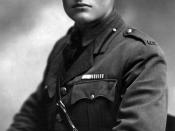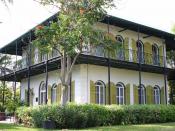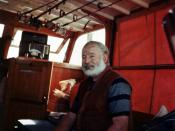Pain and disillusionment, familiar attributes to many people during World War I, are the highlighted human characteristics in the vignette "Nick Sat Against the Wall..." Author Ernest Hemingway utilizes both irony and symbols to communicate to this thought. The vignette opens with a nasty image. Victim to either machine gun fire or shrapnel, Nick is dragged away from immediate danger by comrades. He was propped up against "the wall of the church." This description is both ironic and powerful. While Nick may be lying against the wall of holy venue, so close to a base of religion and salvation, the wall beckons him no support, and he proves to be a long way from any sanctuary. War brings pain, something that not even religion or the almighty can assuage. Clearly war has no place for religion, and right now, though so physically close, there is a definitive barrier between Nick and all that is sacred...God.
The description continues, as Nick sits gazing "brilliantly" at the scope of the damage, an expression reflecting his disillusioned state. The cripple observes "an iron bedstead hung twisted toward the street." This malformed furniture is a direct parallel to Europe's misshapen and scared society. The whole house is shambles, with everything out of place, a symbolic equivalent to Nick's crazed life. However, during this hard time amidst the chaos, he both strives to fill Hemingway's classic man's man role, and tries to make sense of it all and find purpose. The narrator concludes that while both the people and towns may be destroyed, all is not bad. Apparently "things were getting forward in the town" and the fighting "was going well." In reflection, there is simply nothing at all positive or good about war, no matter what the context. War entails an incalculable amount...


